Working with an experienced pediatric audiologist is critical in getting a valid assessment of your child’s hearing. Tests of hearing function in children can be accomplished with a broad range of techniques available to pediatric audiologists.
Hearing testing is done to find out what your baby can hear. Usually an audiologist will do the testing. The audiologist and/or otolaryngologist may do a variety of tests to find out more specific information about:
Pediatric audiologists employ multiple tests (described below) to assess hearing sensitivity. Some procedures are better suited for a particular child, based on age, ability to participate in the testing, medical condition of the child, and so on. A typical method of pediatric hearing assessment employs the “cross-check principle.” That is, the results of a single test are cross-checked by an independent test measure. The audiologist chooses and performs different tests to get the most accurate determination of a child’s hearing abilities.
Objective tests of hearing do not require active participation from the child and are often very helpful in assessing hearing levels .
How it is done: A small probe is placed in the child’s ear canal. A sound, generated by the testing equipment is sent to the cochlea (inner ear). If the hair cells in the cochlea are functioning normally, they generate an otoacoustic emission that is generated by the testing equipment.
What it will show: If an emission is present, it suggests normal cochlear function. If an emission is not present, then further testing is needed. Generally, children with typical hearing or mild hearing levels will have otoacoustic emissions present. Otoacoustic emissions alone are not enough to diagnose typical hearing.
Who is it for: This test is used for infants, for children who cannot respond to other types of hearing tests, and for children with disabilities. OAEs can be used regardless of a client’s age at testing; as another way to cross-check test results; to help diagnose auditory neuropathy and to monitor hearing when an individual has had noise exposure.
Different types of testing may be known as: Brainstem Audiometry Evoked Response, BSER, BAER, ABR, ASSR
How it is done: This tests hearing from the level of the outer ear through the lower brainstem. This test can be done if the child is either sedated or asleep. Electrodes are attached to the child’s head and earphones are placed on the child’s ears. Sounds are played through the earphones and the electrodes measure how the child’s brain responds. This test gathers specific information about the child’s hearing at different pitches and loudness levels. This test is completely painless.
What it will show: This test gives a close approximation of the child’s hearing sensitivity.
Who is it for: This test is used for infants, for children who cannot respond to other types of hearing tests and for children with severe disabilities.
Also known as: Impedance testing, immittance testing, or tympanometry
May also include: acoustic reflexes
How it is done: A probe is placed in your child’s ear and a signal is presented. There may be a change in pressure depending on what information the audiologist is trying to gather. The signal bounces off the eardrum and back to the probe. It only takes between 3-30 seconds per ear.
What it will show: Tympanometry will chart the way sound enters into the middle ear which shows how the middle ear is functioning. It can help determine if there is a hole in the ear drum or if there is fluid behind the eardrum. This is part of one test that audiologists use to assess eardrum movement, but is not always clear-cut.
Who is it for: Any child.


Subjective tests of hearing require a response from the child.This response can range from a widening of the eyes, to a turning of the head, to a raising of the hand. These responses provide the best indication of what sounds the child responds to and provide the data for the audiogram. Subjective tests can be done using a speaker in the test room (a soundfield system) or earphones. Tests done in the soundfield cannot separate the hearing levels of the left ear from that of the right ear. Tests done with earphones provide the best ear-specific data, allowing for diagnosis of hearing levels for each ear separately.
How it is done: An audiologist observes the child’s reaction to different frequencies and loudness levels. Reactions may include a sucking reflex or head turn.
What it will show: The test relies heavily on parent and provider interpretation. Therefore, the test will only give a rough estimate of the degree of hearing level. Behavioral observation audiometry must be part of a larger test battery.
Who is it for: This test is usually done with very young babies, especially when no other tests are available.
How it is done: The child will either sit in a chair or on the lap of an adult in the sound booth. When the sound is introduced and the child looks to where the sound was presented, a toy will light up. Children will learn to look at the toy in response to the sound, even when the sound is the quietest the child can hear.
What it will show: This test can tell the type and degree of hearing levels at different pitches.
Who is it for: This test is used for infants and young children with adequate neck control to turn towards a stimulus

BE A PART OF IT ALL.
We hope you will consider making a gift to support these children. Thank you!

Sign up to be the first to know about new FHSR resources, programs, and events.
FHSR is a qualified 501(C)(3) tax exempt organization. Tax ID number 36-6082810.

FHSR’s MARCOM Gold Award-Winning Website was developed in collaboration with Carlson Integrated, LLC.
MarCom Awards is an international creative competition that recognizes outstanding achievement by marketing and communication professionals. MarCom Awards is administered and judged by the Association of Marketing and Communication Professionals. Judges are industry professionals who look for companies and individuals whose talents exceed a high standard of excellence and whose work serves as a benchmark for the industry. There were over 6,000 entries from 41 countries in the MarCom Awards 2021 competition.